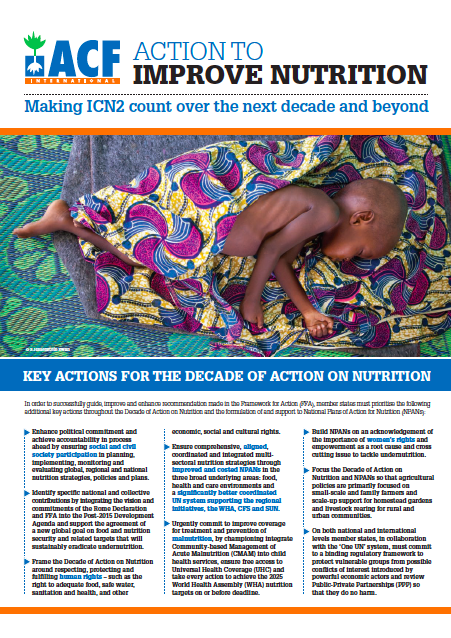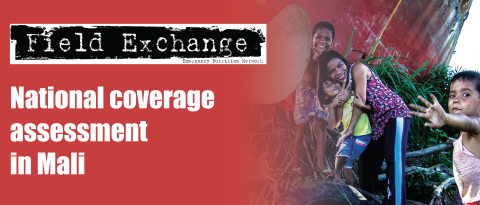ICN2 - from promises to action: ACF’s perspective
 By Samuel Hauenstein Swan and Alex Wijeratna
By Samuel Hauenstein Swan and Alex Wijeratna
Samuel Hauenstein Swan is Senior Policy & Research Advisor at Action Against Hunger International, in charge of policy positioning on hunger, food and nutrition security. He directs ACF’s research strategy and ensures policy coherence and practical field uptake.
Alex Wijeratna is an independent writer and author of Action Against Hunger's recent report, Action to Improve Nutrition, Making ICN2 Count over the next decade and beyond. He has written extensively on food and nutrition issues, including for ActionAid, Caritas, Friends of the Earth and the Fairtrade Foundation.
Jointly organised by the Food and Agricultural Organisation (FAO) and the World Health Organisation (WHO), the Second International Conference on Nutrition (ICN2) in Rome brought together some 2,200 participants, including Member States delegates, United Nations (UN) representatives, non-governmental organisations (NGOs), research groups, the private sector and civil society. FAO Director General, José Graziano da Silva, encouraged “Governments to lead the way for better nutrition for all,” while UN Secretary-General, Ban Ki-moon, called for ambitious national nutrition commitments to be made. His promise, in turn, was that “the UN system pledges to do all that it can to provide effective support” to eradicate malnutrition around the globe in the next decade. The delegates then adopted, as expected, the ‘Rome Declaration on Nutrition1’ and an accompanying ‘Framework for Action2’, which includes 60-plus voluntary policy recommendations for governments to incorporate into their national policies and investment plans.
Given that these recommendations are not legally binding, the question is will these promises largely evaporate after the spotlight of the conference has been switched off, or will they be taken forward in ways that will make ICN2 a turning point for nutrition? What are the next steps for the UN, donors, community groups and civil society organisations? This article summarises ACF’s report, Action to Improve Nutrition, Making ICN2 count over the next decade and beyond3. The report assesses the outcome of ICN2 and presents additional key actions that ACF believes must be carried through into implementation of the proposed ‘Decade of Action on Nutrition’ in order to successfully guide, improve and enhance National Plans of Action for Nutrition (NPANs).
With over 800 million people currently going to bed hungry, 162 million children suffering from stunting, approximately 800,000 babies dying every year because they are not optimally breastfed, over two billion suffering from micronutrient deficiencies and 1.4 billion overweight, it is no wonder José Graziano Da Silva said in his opening speech to member states, “I hope that during this conference you will announce targets that go beyond the internationally agreed goals.”
His hopes were largely unmet; there were very few new government commitments proclaimed during this conference. Despite not living up to this expectation, the ICN2 did add momentum and deliver some significant shifts in the global nutrition architecture. The first success of the ICN2 was that the Member States, WHO, FAO, other key UN agencies and civil society have, for the first time, publicly and jointly assumed their duty and commitment to accelerate nutrition-specific and nutrition-sensitive policies into effective national actions. The second success is that it joined up people, bringing together sectors and institutions that do not normally meet in the same forums. The ICN2 was not only about achieving alignment over the assessment of the problems, but also about agreeing on their solutions. The third gain from the conference was that delegates and policy-makers found overlaps in their visions for solutions. Statements from the member states and UN organisations confirmed that the solutions come in many forms. Most of all it was striking that success on tackling nutrition, more often than not, is the result of multiple sector interventions and approaches.
From a civil society perspective, it was an achievement to have galvanised over 150 organisations to participate in a pre-conference and agree on one joint declaration. Never before have grassroots peasants groups, artisanal fishing communities, anti-hunger NGOs and many others come together in this way on malnutrition, affirming a common goal. The path to achieve a shared vision was not always smooth; too many pressing issues perpetuate the nutrition crisis. Civil society and social movements are engaged in delivering a vibrant multitude of local level interventions, and to summarise these is virtually an impossible task. To champion a set of priorities might be seen as no big deal in itself nor is the joint declaration the final judgement about what is needed; however, the trust built during the process is essential to ‘join the dots’ towards joint future advocacy efforts for a better, more accountable and responsive global governance system for improved nutrition, food and health.
The ICN2’s attainments are still far too weak to be sufficient to guarantee the success of a ‘Decade of Action’ on nutrition, but they are essential stepping stones to get there. In the few months since the meeting, both the WHO and FAO have reaffirmed their commitment made in the outcome documents of this conference. Most prominent gains include the tabling of the call for the ‘Decade of Action on Nutrition’ at the UN General Director’s level, the creation of an anticipated ‘Action for Nutrition Trust Fund’ to mobilise much needed resources to finance nutrition initiatives and the commitment by both WHO and FAO to step up their support to countries in establishing comprehensive nutrition strategies and enable effective programming and monitoring.
In summary, we believe ICN2 galvanised an unprecedented engagement on malnutrition; the onus is now on affected governments to urgently review, cost and assess the recommended policies and actions in relation to national needs, conditions and priorities, and decide – informed by the ongoing and active participation of civil society, social movements and those most affected by malnutrition – on the additional action to be taken in national policies and investment plans. ACF’s Action for Nutrition report outline the direction we propose to go as an NGO, in 2015 and beyond, from the nutrition perspective.
In the coming years, governments, UN bodies, NGOs and civil society must maximise support, involvement and, indeed, ownership of policies, from their inception to implementation; this is key to safeguard the attainments we have been part of securing over the past year and a half. This future journey must start with WHO and FAO but must lead quickly to all five UN organisations on hunger and nutrition (WHO, FAO, UNICEF, World Food Programme (WFP) and the International Fund for Agricultural Development ( IFAD)), spread to Member States and rapidly reach populations most affected by nutrition. One of the first tests for the legacy of ICN2 will be integrating the vision and commitments of the ICN2 into the Post-2015 Development Agenda later this year and supporting the agreement of a new global goal on food and nutrition security and related targets that will sustainably eradicate malnutrition in all its forms by 2025.
For more information, contact: Samuel Hauenstein Swan, email: s.hauensteinswan@actionagainsthunger.org.uk
1 The Declaration is available at: http://www.fao.org/3/a-ml542e.pdf
2 The Framework for Action is available at: http://www.fao.org/3/a-mm215e.pdf


